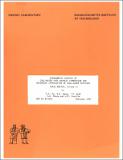| dc.contributor.author | Beř, J. M. | en_US |
| dc.contributor.author | Sarofim, Adel F. | en_US |
| dc.contributor.other | Massachusetts Institute of Technology. Massachusetts Institute of Technology. Energy Laboratory. Dept. of Chemical Engineering. | en_US |
| dc.date.accessioned | 2011-01-14T23:29:42Z | |
| dc.date.available | 2011-01-14T23:29:42Z | |
| dc.date.issued | 1987 | en_US |
| dc.identifier.uri | http://hdl.handle.net/1721.1/60639 | |
| dc.description.abstract | This Final Report is issued in two volumes, covering research into the combustion of Coal Water Fuels (CWF). Two separate but related tasks are discussed; Volume I contains results obtained under Task 1 - Fundamental aspects of Coal-Water Fuel Droplet Combustion in which the experiments were carried out in Laminar Flow Reactors. The present report, Volume II, covers experiments under Task 2 - "Secondary Atomization of Coal-Water Mixtures". | en_US |
| dc.description.abstract | Three methods of improving spray fineness by fuel treatment were investigated - 1) the heating of the CWF under pressure to produce steam as the pressure drops during passage of the CWF through the atomizer nozzle 2) the absorption of CO02 gas in the CWF to produce a similar effect, and 3) the addition of a chemical additive which will cause microexplosions in the droplets upon heating. These treatments are expected to produce disruptive atomization, i.e., the disintegration of slurry droplets subsequent to their leaving the atomizing nozzle, and therefore to yield better burnout and finer fly ash particle size distribution upon combustion. The effects of disruptive atomization upon CWF spray size distribution were studied using a spray test chamber equipped with a laser diffraction particle size analyzer; the data were fitted to the Rosin-Rammler particle size distribution function. The combustion characteristics of the treated CWFs were investigated in the MIT Combustion Research Facility. | en_US |
| dc.description.abstract | The spray chamber tests established that thermally-assisted atomization produced reductions both in the mean droplet size and in the mass fraction of large particles in the spray. For fuel delivery temperatures up to 100*C this effect is attributable to lowered fuel viscosity, while further heat of the CWF (to 1500C in these experiments) produces disruptive atomization. | en_US |
| dc.description.abstract | In-flame measurements and high speed cine pictures made during combustion tests provided detailed information for comparisons of treated and untreated CWF. Thermally-assisted atomization was the most effective of the methods studied for improving carbon conversion efficiency and reducing fly ash particle size. CO02 and picric acid addition techniques showed substantial improvements but they were less effective. | en_US |
| dc.description.sponsorship | Prepared for United States Department of Energy, Pittsburgh Energy Technology Center, Fossil Energy Program. | en_US |
| dc.format.extent | 1 v. (various pagings) | en_US |
| dc.publisher | Cambridge, Mass. : Massachusetts Institute of Technology, Energy Laboratory and Department of Chemical Engineering, [1987] | en_US |
| dc.relation.ispartofseries | Energy Laboratory report (Massachusetts Institute of Technology. Energy Laboratory) no. MIT-EL 87-003. | en_US |
| dc.title | Fundamental aspects of coal-water fuel droplet combustion and secondary atomization of coal-water mixtures. Volume II, final report | en_US |
| dc.title.alternative | Secondary atomization of coal-water mixtures, Fundamental aspects of coal-water fuel droplet combustion and. | en_US |
| dc.identifier.oclc | 21242880 | en_US |
